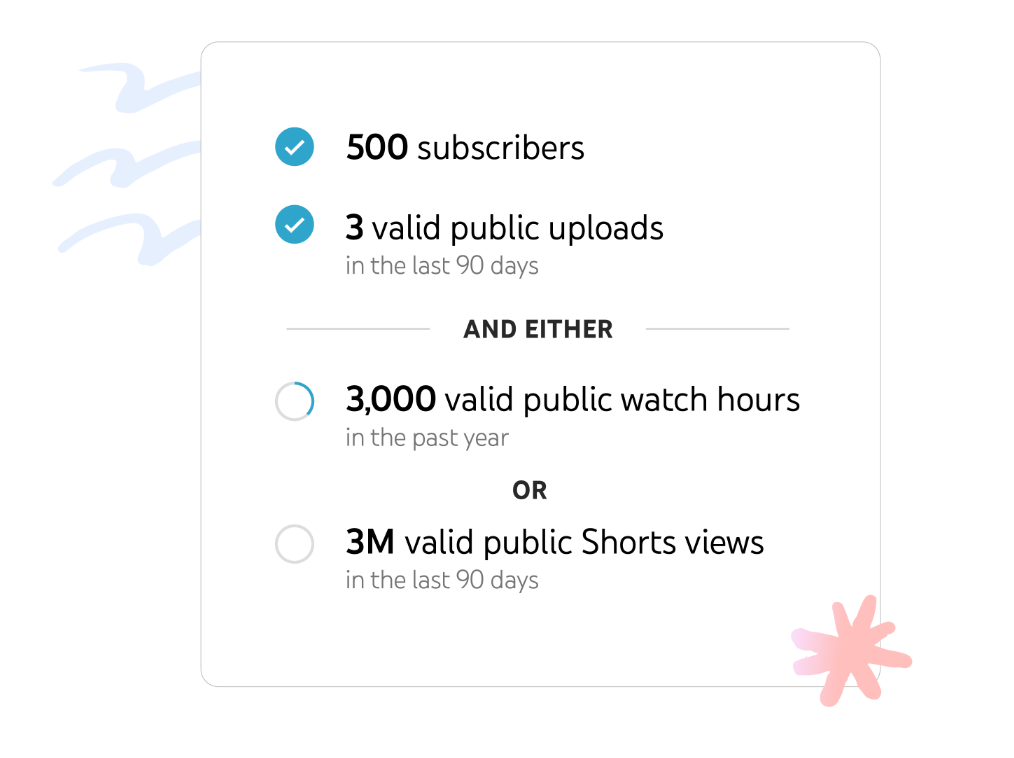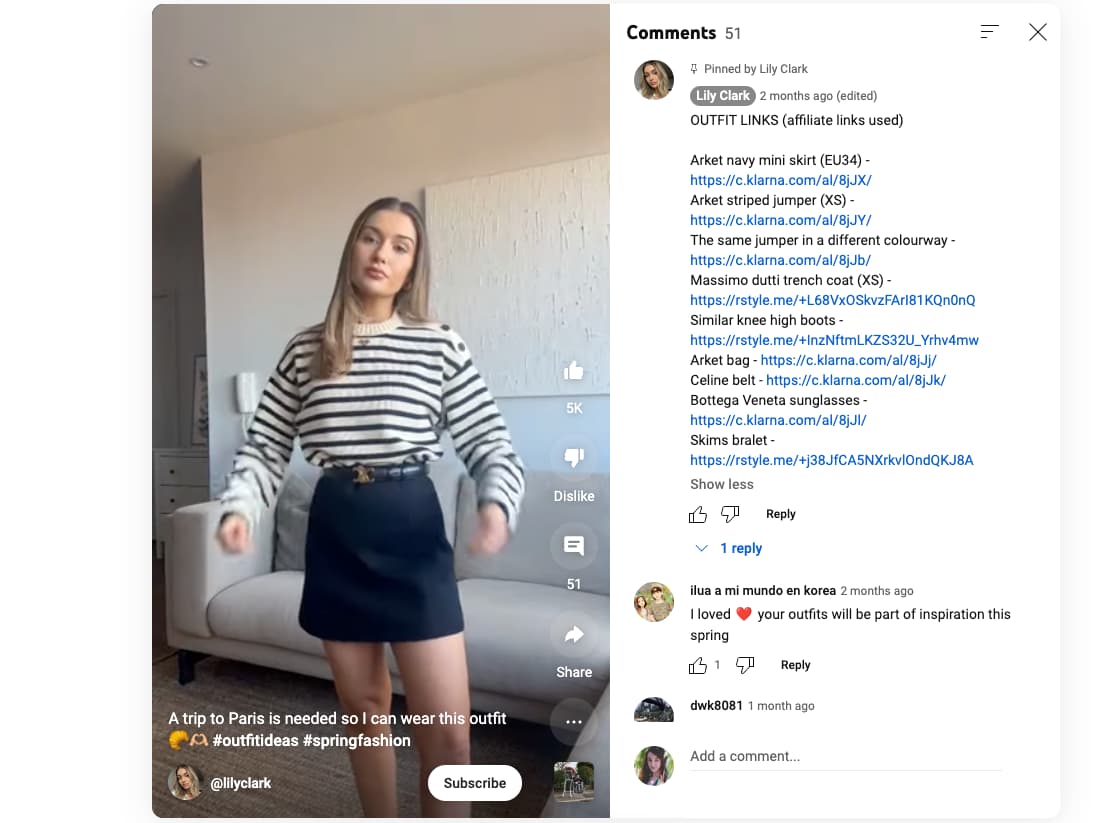The Ultimate Guide to YouTube Shorts Monetization
Learn five different strategies for monetizing your YouTube Shorts presence, including strategies that work for accounts that aren't part of the YouTube Partner Program.

After the rise of TikTok and the advent of Instagram Reels, YouTube answered the call of short, vertical video by introducing Shorts.
Just like those other apps, Shorts offer a never-ending feed of short videos, and it also comes with some powerful monetization capabilities.
Shorts creators are eligible for the Partner Program, meaning creators are able to earn money from gaining views for their Shorts. Similar to how creators can earn revenue from ads played before a long-form YouTube video, the Partner Program for Shorts means creators earn a part of the revenue for ads played between Shorts. This money comes from what’s called the Creator Pool.
However, that’s not the only path to Shorts monetization.
YouTube Shorts monetization ideas:
- YouTube Partner Program
- Creating sponsored videos
- Selling merch
- Affiliate product sales
- Sell a product or service
This article explains all the options for making money from Shorts, starting with the YouTuber Partner Program.
How to Monetize YouTube Shorts with the YouTube Partner Program
When Shorts first launched on YouTube, it came with a creator fund that paid those who posted Shorts and offered an incentive to use the new format.
That fund has since been sunsetted and now Shorts have been rolled in the regular Partner Program. The Partner Program is a revenue sharing model, meaning creators are earning a portion of ad revenue. YouTube runs ads between videos in the Shorts feed, so the money creators earn is a portion of that ad revenue.
Youtube Partner Program Eligibility Requirements
The first step to monetize Shorts through YouTube’s Partner Program is to qualify for the Partner Program. Updated in June 2023, eligible channels must meet three relevant criteria for ad sharing:

- Gain 500 subscribers
- Have 3 valid public uploads in the last 90 days
- Achieve 3 Million valid public shorts views in the last 90 days
Once you've achieved these milestones, you'll unlock the Earn area of YouTube Studio. If you qualify for the program based on long-form videos, you’re also able to monetize Shorts, and vice versa. That means no matter how you qualify, you’re incentivized to make Shorts.
Once you become eligible based on these requirements, you must apply to become a Partner in the Earn area of YouTube Studio. YouTube will then review your channel to determine if you can join YouTube’s Partner Program. Note that to get approved, your channel must comply with all YouTube Community guidelines and policies.
Once approved, you give YouTube payment information and you can immediately start earning from the creator pool.
Related Article: Top YouTube Stats You Should Know in 2023
A different kind of revenue sharing model for Shorts
Shorts ad revenue sharing does work a bit differently than long-form video, however. Whereas ad revenue is split just between YouTube and the creator for long-form video, for Shorts music usage also plays a role.
Shorts typically contain copyrighted music. The great news is that music usage is free and without restrictions — the catch is that the music publisher also earns a cut of the revenue sharing.
YouTube collects revenue from Shorts ads into a creator pool. If you use one music track in a Short, the creator pool is split 50/50 between you and the music publisher. If two tracks are used, the publisher gets 66% of the revenue and 33% of the creator pool goes to the creator.
For Shorts that don’t use any music tracks, 100% of the creator pool goes to the creator.
The payment amount also takes into account the number of views your Shorts get. You should also know that YouTube only counts authentic views, so watching your own Shorts over and over won’t cut it, and neither will bots. YouTube also won’t monetize Shorts that are blatant reposts of another creator’s content. That extends to publishing your own content from other channels and leaving the TikTok or Reels watermark on.
To avoid having your repurposed content demonetized, use a third-party editing tool like Kapwing to remove that watermark before uploading to YouTube Shorts.
The Program is different from TikTok which doesn’t use a revenue sharing model but rather a creator fund.
How much can you earn from Shorts ad revenue sharing?
The answer to this is a little murky. Shorts creators have no control over where and when ads appear in the Shorts feed.
It’s estimated that Shorts creators can earn up to $3 per 1,000 views but VidIQ shared that they were only paid $16.61 for 468,500 views — which works out to far less. By comparison, according to Yahoo Finance, the average YouTuber makes $0.18 per view for long-form content.
Overall, it’s very difficult to make significant income from Shorts alone unless you’re consistently gaining millions of views per video.
4 ideas for YouTube Shorts monetization
Whether you’re not yet eligible for the Partner Program, or you’re looking to earn more revenue, here are four ways to earn money from Shorts beyond the Partner Program.
1. Create sponsored Shorts videos
Perhaps the most lucrative way to monetize Shorts is to create sponsored content. This is when a brand pays you to create a Short that showcases their products or services in some way.
For example, take a look at this Short from cake maker @tiggamac that’s also an ad for Bershka bags.
Payments for sponsored posts can vary greatly, and are typically based on your average views and your subscriber count. The more popular your channel is, the more you can ask for from brands. You can also charge more if you offer to create both long-form videos and Shorts, and if you can offer a package that includes posts on other social media apps such as TikTok or Instagram.
2. Sell merch
If you’ve managed to build a popular YouTube channel through posting Shorts, you’ll have many fans who want to support you. One of the ways they can do that is by purchasing branded fan merchandise.
To start, you’ll need to create designs, have them produced, and create an e-commerce site to sell them on. Alternatively, you can use a service that does the creation for you, such as Spreadshop, Bonfire or Spring.
Since you can’t place a link directly in a Short, make sure to mention your merch in your Shorts and provide a link from your YouTube profile page.
Here’s an example of Mr. Beast hyping up his merch line in a YouTube Short. Notice that he tells viewers exactly where to go to get it for themselves.
3. Join an affiliate program
Affiliate programs allow you to earn money by promoting products. You provide product links to your fans and, if they make a purchase, you get a cut of the revenue.
This is a great idea if you love reviewing products in your Shorts or simply have a brand you already know and love.
To become an affiliate, sign up with a brand or affiliate network to get started. The Amazon Associates program is one of the most popular choices, but numerous other brands and networks offer affiliate links.
Again, because you can’t add a link to a Short, you’ll have to get creative about directing your viewers to the links. For example, this creator shares a lot of OOTD (outfit of the day) content featuring items that she has affiliate links for:
Because she can't add a link in the caption of the Short, she lists her affiliate links for in a pinned comment, letting viewers know where to go to steal her look (and that purchasing from those links will support her and her content). Here's an example of what those pinned comments look like:

4. Sell a product or service
If you sell anything online, whether it’s a physical product, a digital product, or a service, Shorts are a great place to promote it.
Try creating Shorts that show off your products, show a look behind the scenes of your business, or highlight reviews from customers.
Here, for example, sticker shop owner @brittanyobarr shows herself creating a sticker for sale.
Monetize YouTube Shorts and make money
With TikTok and Instagram also competing in the short-form video space, YouTube is invested in incentivizing creators to make Shorts. That’s why they’re now eligible for revenue sharing through the Partner Program.
While the Program itself doesn’t pay much, there are other ways to make money through creating Shorts. Combined with long-form YouTube content, Shorts can be a path towards earning money from posting videos on YouTube.
YouTube Shorts monetization FAQ
1. Can YouTube Shorts be monetized?
Yes! YouTube Shorts creators are eligible for the Partner Program. This is a revenue sharing model that allows creators to earn a portion of ad revenue from ads shown in the Shorts feed. You must have at least 1,000 subscribers in addition to other requirements.
2. How is YouTube Shorts monetization changing?
Originally, Shorts creators could only earn revenue through the YouTube Shorts Fund, however they are now eligible for revenue sharing through the Partner Program. This allows creators to earn a portion of the revenue from ads shown in the Shorts feed.
3. Can you earn money from YouTube Shorts?
Yes! You can apply in YouTube Studio to the YouTube Partner Program for Shorts ad revenue sharing. You can also create sponsored videos, sell merch, join an affiliate program, or promote products or services. If you have a long-form video, you can try using our AI YouTube Shorts Generator to automatically get the best clips to use for YouTube Shorts.
4. How much does YouTube Shorts pay for 100k views?
Payments vary but it’s estimated that you can earn $3 per 1,000 views through ad revenue sharing.
5. How do I turn on monetization on YouTube Short?
You must apply for and be accepted into the YouTube Partner Program to monetize short form content with revenue sharing. You will then be able to earn some of the ad revenue generated.









